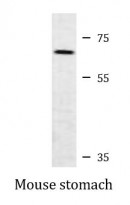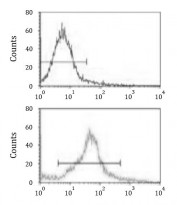ARG42075
anti-CREB3L1 / OASIS antibody
anti-CREB3L1 / OASIS antibody for Flow cytometry,IHC-Formalin-fixed paraffin-embedded sections,Western blot and Human,Mouse
Overview
| Product Description | Rabbit Polyclonal antibody recognizes CREB3L1 / OASIS |
|---|---|
| Tested Reactivity | Hu, Ms |
| Tested Application | FACS, IHC-P, WB |
| Host | Rabbit |
| Clonality | Polyclonal |
| Isotype | IgG |
| Target Name | CREB3L1 / OASIS |
| Antigen Species | Human |
| Immunogen | KLH-conjugated synthetic peptide between aa. 481-509 of Human CREB3L1. |
| Conjugation | Un-conjugated |
| Alternate Names | Old astrocyte specifically-induced substance; OASIS; cAMP-responsive element-binding protein 3-like protein 1; Cyclic AMP-responsive element-binding protein 3-like protein 1 |
Application Instructions
| Application Suggestion |
|
||||||||
|---|---|---|---|---|---|---|---|---|---|
| Application Note | * The dilutions indicate recommended starting dilutions and the optimal dilutions or concentrations should be determined by the scientist. | ||||||||
| Positive Control | Mouse stomach | ||||||||
| Observed Size | ~ 68 kDa |
Properties
| Form | Liquid |
|---|---|
| Purification | Saturated Ammonium Sulfate (SAS) precipitation followed by dialysis against PBS. |
| Buffer | PBS and 0.09% (W/V) Sodium azide. |
| Preservative | 0.09% (W/V) Sodium azide. |
| Storage Instruction | For continuous use, store undiluted antibody at 2-8°C for up to a week. For long-term storage, aliquot and store at -20°C or below. Storage in frost free freezers is not recommended. Avoid repeated freeze/thaw cycles. Suggest spin the vial prior to opening. The antibody solution should be gently mixed before use. |
| Note | For laboratory research only, not for drug, diagnostic or other use. |
Bioinformation
| Database Links |
Swiss-port # Q96BA8 Human Cyclic AMP-responsive element-binding protein 3-like protein 1 Swiss-port # Q9Z125 Mouse Cyclic AMP-responsive element-binding protein 3-like protein 1 |
|---|---|
| Gene Symbol | CREB3L1 |
| Gene Full Name | cAMP responsive element binding protein 3-like 1 |
| Background | The protein encoded by this gene is normally found in the membrane of the endoplasmic reticulum (ER). However, upon stress to the ER, the encoded protein is cleaved and the released cytoplasmic transcription factor domain translocates to the nucleus. There it activates the transcription of target genes by binding to box-B elements. [provided by RefSeq, Jun 2013] |
| Function | Transcription factor involved in unfolded protein response (UPR). Binds the DNA consensus sequence 5'-GTGXGCXGC-3' (PubMed:21767813). In the absence of endoplasmic reticulum (ER) stress, inserted into ER membranes, with N-terminal DNA-binding and transcription activation domains oriented toward the cytosolic face of the membrane. In response to ER stress, transported to the Golgi, where it is cleaved in a site-specific manner by resident proteases S1P/MBTPS1 and S2P/MBTPS2. The released N-terminal cytosolic domain is translocated to the nucleus to effect transcription of specific target genes. Plays a critical role in bone formation through the transcription of COL1A1, and possibly COL1A2, and the secretion of bone matrix proteins. Directly binds to the UPR element (UPRE)-like sequence in an osteoblast-specific COL1A1 promoter region and induces its transcription. Does not regulate COL1A1 in other tissues, such as skin (By similarity). Required to protect astrocytes from ER stress-induced cell death. In astrocytes, binds to the cAMP response element (CRE) of the BiP/HSPA5 promoter and participate in its transcriptional activation (By similarity). Required for TGFB1 to activate genes involved in the assembly of collagen extracellular matrix (PubMed:25310401). (Microbial infection) May play a role in limiting virus spread by inhibiting proliferation of virus-infected cells. Upon infection with diverse DNA and RNA viruses, inhibits cell-cycle progression by binding to promoters and activating transcription of genes encoding cell-cycle inhibitors, such as p21/CDKN1A (PubMed:21767813). [UniProt] |
| Cellular Localization | Endoplasmic reticulum membrane; Single-pass type II membrane protein. Note=ER membrane resident protein. Upon ER stress, translocated to the Golgi apparatus where it is cleaved. The cytosolic N-terminal fragment (processed cyclic AMP-responsive element-binding protein 3-like protein 1) is transported into the nucleus. Processed cyclic AMP-responsive element-binding protein 3-like protein 1: Nucleus. Note=Upon ER stress, transported into the nucleus. [UniProt] |
| Calculated MW | 57 kDa |
| PTM | Upon ER stress, translocated to the Golgi apparatus, where it is processed by regulated intramembrane proteolysis (RIP) to release the cytosol-facing N-terminal transcription factor domain. The cleavage is performed sequentially by site-1 and site-2 proteases (S1P/MBTPS1 and S2P/MBTPS2). RIP is induced by TGFB1 and ceramide (PubMed:25310401, PubMed:27499293). N-glycosylated. Ubiquitinated by HRD1/SYVN1; undergoes 'Lys-48'-linked ubiquitination, followed by rapid proteasomal degradation under normal conditions. Upon ER stress, SYVN1 E3 ubiquitin-protein ligase dissociates from its substrate, ubiquitination does not occur and CREB3L1 is stabilized. [UniProt] |
Images (3) Click the Picture to Zoom In
-
ARG42075 anti-CREB3L1 / OASIS antibody IHC-P image
Immunohistochemistry: Formalin-fixed and paraffin-embedded Human prostate carcinoma tissue stained with ARG42075 anti-CREB3L1 / OASIS antibody.
-
ARG42075 anti-CREB3L1 / OASIS antibody WB image
Western blot: 35 µg of Mouse stomach lysate stained with ARG42075 anti-CREB3L1 / OASIS antibody.
-
ARG42075 anti-CREB3L1 / OASIS antibody FACS image
Flow Cytometry: HeLa cells stained with ARG42075 anti-CREB3L1 / OASIS antibody (bottom histogram) or without primary antibody as control (top histogram), followed by incubation with FITC labelled secondary antibody.








